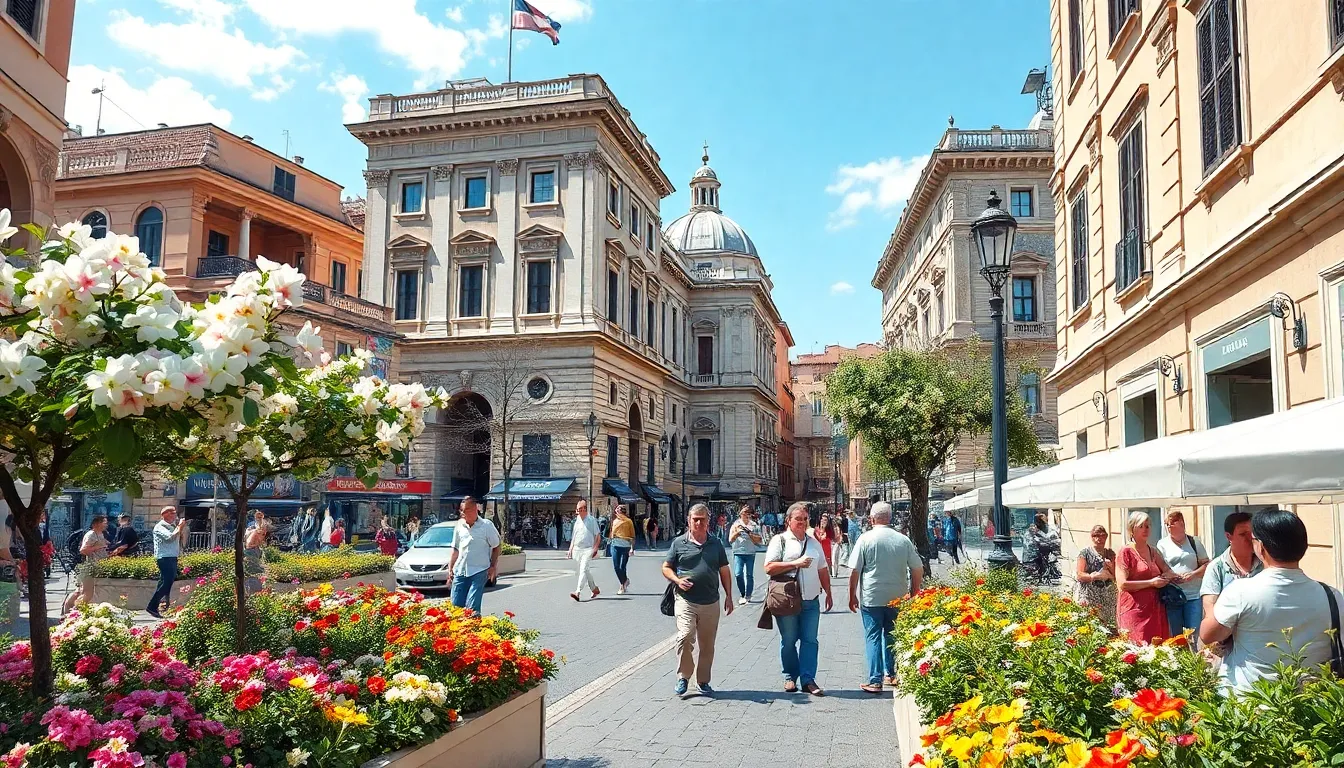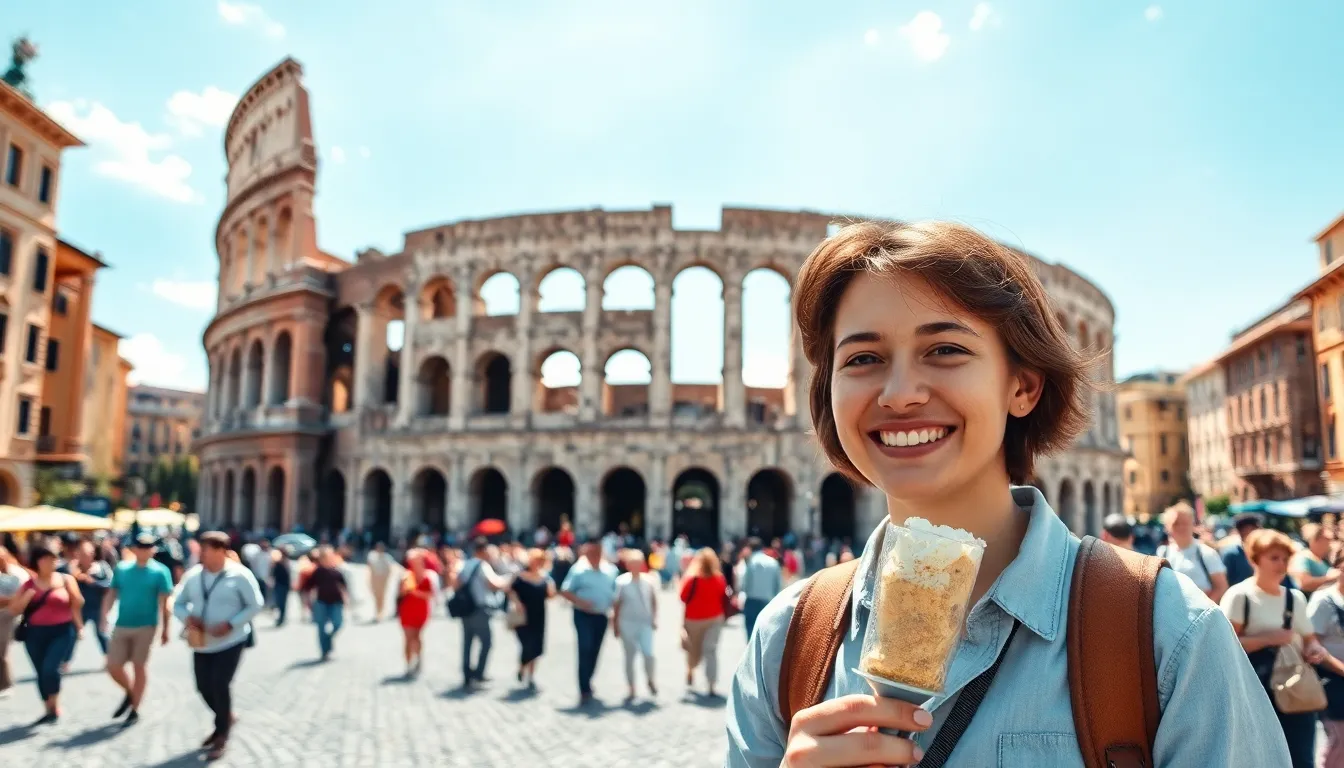Table of Contents
TogglePlanning a trip to Rome? Get ready to indulge in mouthwatering pasta, awe-inspiring architecture, and a sprinkle of chaos that only this Eternal City can offer. But before he dives into the Colosseum or she sips an espresso like a local, a few savvy travel tips can turn a good trip into an unforgettable adventure.
Essential Rome Travel Tips
Pack comfortable shoes for walking. Rome features numerous cobblestone streets and historic sites requiring exploration on foot. Knowing the best times to visit attractions is crucial. Early mornings or late afternoons typically avoid larger crowds.
Stay hydrated, especially during warmer months. Access to fresh water is widespread, with many public fountains available throughout the city. Utilize public transport to save time. Buses and the metro system efficiently connect key destinations at a reasonable cost.
Consider purchasing a Roma Pass. This pass offers discounts on public transportation and admission to various museums, making it a cost-effective choice. Experience local cuisine by seeking out trattorias and pizzerias frequented by locals. Authentic dishes provide a true taste of Roman culture.
Learn basic Italian phrases. Simple greetings or expressions show appreciation for the locals and enhance interactions. Understanding the layout of the city helps in navigating its rich history. Familiarize oneself with districts such as Trastevere for a vibrant nightlife or the historical center for iconic landmarks.
Stay aware of pickpockets, especially in crowded areas. Carry belongings securely and maintain vigilance. Enjoying a gelato as a snack is part of the Roman experience. Choose from countless flavors while soaking in the atmosphere at piazzas.
Respect local customs and traditions. Proper etiquette enhances the overall visit while fostering goodwill. Exploring lesser-known sites provides a deeper insight into Rome’s culture. Hidden gems often reveal a different perspective of the city.
Best Time to Visit Rome

Finding the best time to visit Rome greatly enhances the travel experience. Seasons in Rome offer different advantages and opportunities.
Weather Considerations
Spring, from March to May, features mild temperatures and blooming flowers, making it an ideal time for sightseeing. Summer, lasting from June to August, attracts many tourists, resulting in crowded attractions and higher temperatures, often reaching 90°F (32°C). Autumn, spanning September to November, showcases pleasant weather and stunning foliage, providing a great atmosphere for exploration. Winter, particularly December through February, offers cooler temperatures, averaging around 50°F (10°C), and fewer crowds, which allows for a more relaxed visit.
Major Events and Festivals
Visiting during festive periods provides unique experiences. The Feast of the Immaculate Conception, held on December 8, attracts visitors to vibrant celebrations. Easter, usually in March or April, transforms the city with various religious events, including the Pope’s Mass at St. Peter’s. The Roman Summer Fest, running from June through September, features concerts and open-air movies, making evenings enjoyable. Additionally, the Rome Film Fest in October showcases international cinema and draws film enthusiasts. Planning around these events ensures memorable experiences in Rome.
Getting Around Rome
Navigating Rome’s transportation options enhances the travel experience. Efficient systems exist for exploring the city’s many attractions.
Public Transportation Options
Rome offers a comprehensive public transport network. Buses, trams, and the metro provide easy access to key destinations. The metro operates three lines, connecting major areas and attractions. Investing in a Roma Pass can save money on transportation while including discounts for museums. Buses and trams cover gaps not served by the metro. Schedules for public transport can be found online or through apps, helping travelers plan their journeys effectively.
Walking and Biking
Walking remains a popular way to experience Rome’s charm. Cobblestone streets invite exploration, leading to hidden gems and local eateries. Biking also offers a unique perspective of the city. Bike-sharing programs like “Bike Sharing Roma” provide convenient rentals. Routes designed for cyclists help navigate busy streets safely. Strolling or biking allows visitors to appreciate the architecture and ambiance intimately. Enjoying the city’s sights on foot or two wheels adds depth to the travel experience.
Must-See Attractions
Rome offers a wealth of attractions, blending history and culture in every corner. Visitors should prioritize experiencing both iconic sites and hidden treasures during their stay.
Historical Landmarks
The Colosseum stands as a monumental testament to ancient Roman engineering. This iconic amphitheater hosted gladiatorial contests, drawing thousands of spectators. The Roman Forum, once the heart of public life, enables an exploration of ruins that tell the story of Rome’s political and social history. St. Peter’s Basilica dominates the Vatican City skyline, showcasing breathtaking architecture and art. The Pantheon, known for its impressive dome, remains remarkably well-preserved, inviting admiration from all who enter. Each site offers a unique glimpse into Rome’s illustrious past.
Hidden Gems
Trastevere, a charming neighborhood, boasts narrow, cobblestoned streets lined with vibrant buildings. This area provides a perfect backdrop for experiencing local culture and cuisine. Santa Maria in Trastevere, a stunning church, features charming mosaics that captivate visitors. The Aventine Keyhole reveals a unique view of St. Peter’s Basilica through a lush garden gate, creating a postcard-worthy moment. Villa Borghese, a sprawling park, offers a peaceful escape filled with art museums and manicured gardens. Exploring these lesser-known attractions enhances understanding of Rome beyond the usual tourist path.
Local Cuisine and Dining Tips
Rome’s culinary scene offers an array of mouthwatering dishes and dining experiences. Exploring local cuisine enhances any trip to the city.
Traditional Dishes to Try
Pasta alla Carbonara stands out as a must-try dish, featuring eggs, cheese, guanciale, and black pepper. Roman-style Pizza al Taglio, served by the slice, showcases a variety of toppings and crisp, airy dough. Another staple, Saltimbocca alla Romana, consists of thin veal cutlets topped with prosciutto and sage, creating a flavorful combination. Artichokes, especially the Jewish-style deep-fried version, offer a unique taste of the region’s vegetable dishes, while classic Tiramisù delivers a sweet finish to any meal. Visitors should savor these traditional offerings to truly experience Rome’s culinary heritage.
Best Local Restaurants
Trattoria Da Enzo, located in Trastevere, provides a welcoming atmosphere and authentic Roman dishes. Osteria Bonelli, near the Testaccio neighborhood, delights diners with its classic recipes and seasonal ingredients. For a more upscale dining experience, Il Pagliaccio serves creative, refined dishes that showcase local flavors. Pizzeria Ai Marmi, known for its thin-crust pizza, attracts locals and tourists alike with its simple yet delicious offerings. Finally, Mercato di Testaccio offers a vibrant market environment where visitors can sample various dishes from multiple vendors, adding a touch of local flavor to their culinary adventure.
Cultural Etiquette
Cultural etiquette in Rome enhances the travel experience. Understanding local customs fosters goodwill and respectful interactions.
Dos and Don’ts
Do greet with a friendly “Buongiorno” before engaging in conversation. Don’t wear revealing clothing when visiting churches; this includes covering the shoulders and knees. Do take time to enjoy meals; eating quickly is seen as impolite. Don’t ask for alterations to traditional dishes, as it may come off as disrespectful to the chef. Do respect personal space, especially in crowded areas. Avoid loud conversations, particularly on public transport or in quieter neighborhoods. Lastly, do remember that tipping is appreciated but not mandatory; rounding up your bill or leaving small change suffices.
Communication Tips
Understanding basic Italian phrases enhances interaction with locals. Start with simple greetings like “Ciao” for “Hello” and “Arrivederci” for “Goodbye.” Asking for assistance in Italian, such as “Per favore, mi aiuti?” (Please help me), shows respect for the culture. Locals appreciate efforts to speak their language, even if it’s just small phrases. Listening patiently is crucial; Italians enjoy expressing themselves. If someone speaks quickly, nodding conveys interest. They often value eye contact during conversations, as it shows engagement. Using hand gestures is common, so don’t hesitate to express enthusiasm through them.
Exploring Rome is a journey filled with rich history and vibrant culture. By following the travel tips shared, visitors can navigate the city with ease and fully immerse themselves in its unique charm. From savoring authentic Roman cuisine to discovering hidden gems away from the crowds, every moment in this iconic city can become a cherished memory.
Understanding local customs and basic Italian phrases fosters meaningful interactions and enhances the overall experience. Whether it’s wandering through ancient streets or enjoying gelato in a bustling piazza, Rome offers endless opportunities for adventure. With the right preparation and an open heart, every traveler can create their own unforgettable Roman story.




